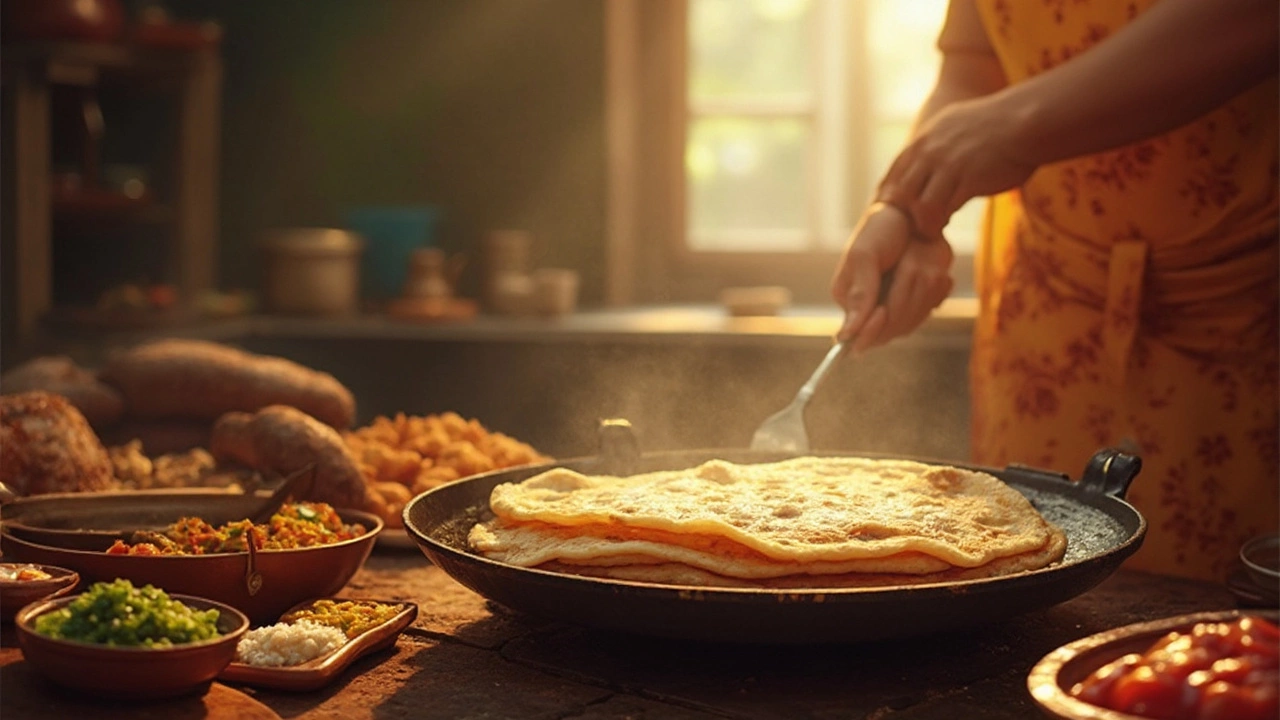Does Roti Make You Gain Weight? Find Out Here!
 Feb, 21 2025
Feb, 21 2025
Ever wondered if that delicious piece of roti on your plate could be the culprit behind weight gain? Don’t worry, you're not alone. Roti, a widely beloved flatbread, often sparks curiosity and concern alike when it comes to calorie counting.
The real question on everyone's mind is how much do calories in 1 roti actually contribute to our daily intake? Depending on the size and ingredients used, calories in 1 roti typically range between 70-120. That’s right, it's not as villainous as some might think.
But let's be real, just knowing the calories in 1 roti doesn't solve the puzzle. What about when you add a dollop of ghee or serve it with that flavorful sabzi? Calories in 1 roti with ghee can tip the scale, adding another 100 calories. Calories in 1 roti and sabzi depend largely on how the sabzi is prepared, commonly varying between 150-300 additional calories.
Before you panic, let's explore the journey roti takes through your diet. Understanding this can help you navigate your meals intelligently, keeping indulgence guilt-free yet satisfying. Stick around as we dive deeper into how roti can joyfully fit into your diet without derailing your nutritional goals.
- Understanding the Basics
- Calorie Breakdown
- Roti vs. Other Carbs
- Healthy Combinations
- Tips for Including Roti in Your Diet
Understanding the Basics
First things first, let's get to know our subject. Roti is a type of unleavened bread popular in many South Asian countries. It's typically made from whole wheat flour, water, and sometimes salt. Sound simple? It is!
Roti Nutritional Breakdown
The staple question: how many calories in 1 roti? That's where all eyes are focused. On average, a medium-sized roti has around 70 to 120 calories. It's low in fat and provides a portion of your daily carbohydrate needs. But, like all foods, moderation is key.
Here's a closer look:
| Nutrient | Approx. Per Roti |
|---|---|
| Calories | 70-120 |
| Carbohydrates | 15-20g |
| Protein | 2-3g |
| Fat | 0.5-1g |
Common Misconceptions
Many believe that eating roti guarantees weight gain, but that's not entirely justified. The concern often lies in the portions and accompaniments like curries and ghee. Remember, the issue might not be with the roti itself but with how it's consumed.
Now, wondering how to enjoy roti without overdoing it? Follow this simple guide:
- Watch Your Portions: Start with one roti and savor it slowly. It helps with portion control and satisfaction.
- Pair Smartly: Combine roti with veggies or lean proteins for a well-balanced meal.
- Limit Add-ons: Be mindful of how much ghee or oil you use to keep calories in check.
Finding balance is essential and makes understanding the basic facts about rota a win-win. So there you have it, with this basic knowledge, you're well-prepared to enjoy roti mindfully and fit it snugly into a healthy diet.
Calorie Breakdown
Alright, let's get into the nitty-gritty of what's really inside your favorite roti. It's essential to know how many calories are in that piece of goodness before we dig in deeper.
Typically, a medium-sized roti made from whole wheat flour averages about 70-120 calories. Want a breakdown of how these calories add up? Here you go:
- Carbohydrates: A major chunk of the calories, usually around 15-20 grams per roti, providing energy for those daily tasks.
- Proteins: Contributing about 2-3 grams, not massive, but it helps keep those muscles strong.
- Fats: These are pretty low, generally under 1 gram if you're keeping it ghee-free.
Now, if you're adding ghee, those calories in 1 roti with ghee can bump up significantly. Ghee cranks up the total by about 100 calories, pushing the entire meal to a richer zone. Oil can have a similar effect, so a heads up there!
The International Journal of Food Sciences notes, 'Incorporating traditional foods like roti can be balanced with modern dietary practices to maintain healthy weight management.'
But that's not all—how about calories in 1 roti and sabzi? Pairing your roti with vegetables like a light sabzi keeps things balanced. But if you're opting for creamy, rich gravies, expect an extra 150-300 calories.
Know Your Options
To make it easy, consider these combos:
- Plain roti with mixed vegetable sabzi: Hovering just under 400 calories for a decent-sized serving.
- Roti with a dollop of ghee and dal: Move this into the 500-calorie range, perfect to keep you satisfied longer.
- For the calorie conscious: Stick with a smaller roti serving with lighter sabzi, aiming for around 300 to 350 calories.
So here’s the takeaway: understanding the calories in 1 roti and how it interacts with your entire meal is crucial for effective, guilt-free planning. Hope this breakdown helps you make smarter choices next time you're at the meal table! Stay tuned as we tackle more in the upcoming sections.

Roti vs. Other Carbs
Roti often stands in the spotlight when comparing carbs. How does it stack up against other popular options like rice, pasta, or bread? This is a common question when planning a balanced meal, especially for those looking to manage their weight or optimize their diet. Let's break it down.
Calorie Comparison
First off, let's talk calories. A single medium-sized roti carries about 70-120 calories. Compare this with cooked white rice, which offers around 200 calories per cup, or store-bought white bread, typically clocking in at 80 calories per slice. Clearly, roti is a moderate option in terms of calories, providing a decent size for sensible portions.
Nutritional Value
Beyond calories, roti's nutrition brings additional benefits. Roti is made from whole wheat flour, preserving fiber essential for digestion. Moreover, it includes essential vitamins and minerals like iron and magnesium. In contrast, many other carbs, especially refined versions, lose these nutrients during processing.
What About Satiety?
Will you feel full? This is crucial for lasting energy and avoiding those sneaky snack trips. The fiber content in a roti is a key player here, helping you stay satisfied longer compared to refined carbs. Plus, it supports steady energy release, without the highs and lows you might experience with refined sugar-rich carbs.
Choosing Your Carbs Wisely
Choosing carbs wisely means looking beyond the caloric count. Here's a simple guide:
- Opt for whole grains or wholemeal versions, which retain more nutrients and fiber.
- Balance your meal with vegetables and protein to support the nutritional value of your carbs.
- Be mindful of portion sizes—when in doubt, check your plate and aim for half veggies, a quarter protein, and a quarter for your carbs.
So if you’re watching your intake, roti could be a smart choice, offering a blend of satisfaction, nutrition, and moderate calorie content. Embrace this versatile carb to help foster a balanced and inclusive diet!
Healthy Combinations
Pairing roti with the right foods can enhance nutrients without tipping the calorie balance unfavorably. The trick is in choosing what accompanies your roti. Roti itself is already a decent source of fiber, and when you pair it smartly, you can keep your meal both tasty and health-conscious.
1. Go Lean with Vegetables
One of the best ways to enjoy roti is with a side of vegetables. Opt for sabzi prepared with minimal oil and plenty of greens like spinach, broccoli, or mixed vegetables. This combination keeps your meal low in calories but high in vitamins and minerals. Notice how the calories in 1 roti and sabzi can be balanced to avoid unnecessary weight gain.
2. Add Some Protein
Don't shy away from adding a protein punch. Pair roti with lentils (daal), chickpeas, or tofu to boost protein intake. Not only does this complete a balanced meal, but it also keeps you fuller longer. Imagine relishing roti with a bowl of nutritious daal—yum!
3. Mindful of the Fats
While fats give flavor, they can also add to your calorie count quickly. If you love calories in 1 roti with ghee, try using ghee sparingly. A little goes a long way, and it’s healthier when used in moderation.
4. Portion Control
Even healthy food can lead to weight gain if you overeat. Count your rotis and stick to a number that suits your calorie goal. This is where understanding how many calories in 1 roti can help plan your intake better. A typical meal might include 1-2 rotis, depending on your dietary needs.
Sample Meal Breakdown
Let’s look at a simple meal plan to get the hang of it:
- 1 Roti: 70-120 calories
- 1 Cup of Mixed Vegetable Sabzi: 150 calories
- Spoon of Ghee (optional): 100 calories
- Total: Approximately 320-370 calories
| Item | Calories |
|---|---|
| 1 Roti | 70-120 |
| Vegetable Sabzi | 150 |
| Ghee | 100 |
If you’re keeping an eye on your calorie intake, sticking to healthy combinations can save the day. Roti doesn't have to be off-limits, but choosing smart pairings and controlling portions can make a world of difference. So embrace balance and enjoy your meals guilt-free!

Tips for Including Roti in Your Diet
Including roti in your diet without gaining weight? Yes, it's possible! Let's break it down into some easy-to-follow steps. We'll look at how to balance your meals while still enjoying this beloved staple.
Plan Your Portion Sizes
One of the simplest ways to ensure you're not overdoing it on calories in 1 roti is by monitoring portion sizes. A regular serving is usually one roti, so if you’re having more than that, make sure to adjust your other meal components accordingly.
Try sticking to roti about the size of your palm. If you feel the need for more, accompany it with low-calorie veggies or a salad which will fill you up without adding extra weight.
Pairing Wisely: Roti with Sabzi
Pairing your roti with the right sabzi can be a game-changer. Opt for vegetable-based sabzis that are grilled or sautéed rather than fried. Include spices and herbs which add flavor without calories. By doing so, you can keep the calories in 1 roti and sabzi in a safe range.
- Use vegetables like spinach, broccoli, or bell peppers.
- Avoid heavy cream-based sauces that spike calorie content.
- Incorporate lentils or beans for added protein without unnecessary fat.
Mindful Use of Ghee
We all love that rich taste of ghee on a hot roti. But those added calories can sneak up on you. If you're generous with the ghee, you might be surprised how much calories in 1 roti with ghee can add to your meal.
The solution? Use a brush to lightly spread ghee, or switch to a healthier fat alternative like olive oil spray, which can cut calories significantly.
Plan Your Entire Day's Intake
It's not just about the calories in 1 roti; it's about your entire day's intake. Ensure that you calculate your meals to leave enough room for enjoying roti without going overboard. Feel free to track your intake using popular health apps – they can provide estimates based on your portion sizes and help you stay on track.
Here's a simple tip:
- Spread your calories evenly throughout the day to avoid feeling too hungry or overindulging at any single meal.
- Keep an eye on both macro and micronutrients – your body needs a balance of all.
- Stay hydrated. Sometimes thirst can mask itself as hunger!
Experiment with Ingredients
Last but not least, consider trying whole wheat or multigrain flour for your roti, which can add fiber and essential nutrients. This switch can help with digestion and keep you fuller longer, reducing overall calorie intake.
By using these tips, you’ll be able to incorporate roti into your diet wisely and enjoyably. Remember, it's about balance, not restriction. With thoughtful planning and creative meal pairing, you can make roti a delightful and healthy part of your nutrition regime.